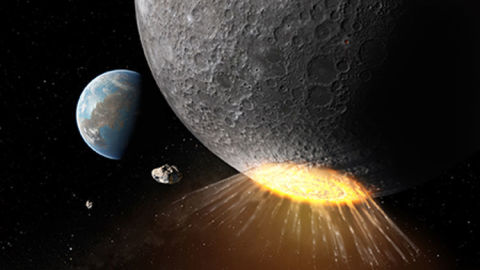Scientists Study the Moon to Learn About Dinosaur Killing Asteroid Impact
Scientists Study the Moon to Learn About Dinosaur Killing Asteroid Impact
The craters on the moon are more pristine than any on Earth, so scientists are using lunar craters to learn about the Chicxulub crater—the terrestrial remnant of an asteroid impact that killed the dinosaurs some 66 million years ago.
The Chicxulub crater, a 102-mile diameter crater in the Yucatán Peninsula of southeastern Mexico, is the result of a six-to-nine-mile-wide asteroid slamming into the Earth. This same asteroid triggered the Cretaceous–Paleogene (K–Pg) extinction event that caused the dinosaurs, along with three-quarters of all plant and animal life on the planet, to go extinct.
The Chicxulub crater is actually underneath the Yucatán Peninsula, and roughly half of it is submerged beneath the Gulf of Mexico. Buried under a kilometer of rock, dirt, sand and water, the Chicxulub crater is rather difficult to study directly.
Advertisement - Continue Reading Below
Fortunately for planetary geologists, the Schrödinger crater on the moon, though twice as big, is remarkably similar to the Chicxulub crater on Earth. Both have an inner circle of mountains called a peak ring that formed at the time of impact within the crater rim. (The Schrödinger crater rim has a diameter of about 200 miles, while the inner peak ring's diameter is about 90 miles.)
MOST POPULAR
The Schrödinger lunar crater is clearly visible, pristine on the surface of the moon for researchers to study with remote sensing techniques. Data from two spacecraft, NASA's Lunar Reconnaissance Orbiter and India's Chandrayaan-1, were used to create an accurate computer model of the impact at Schrödinger on the moon. A research paper detailing the findings was published this morning in Nature Communications.
"If one wants to imagine how the Chicxulub crater looked soon after impact, one only needs to peer at the Schrödinger basin on the moon," said head of the research team, David Kring of the Universities Space Research Association (USRA).
The researchers found that the impact that created the Schrödinger crater pulled rock up from an incredible 18.5 miles below the surface and hurled it up to about 12.5 miles in altitude, or more than twice the height of Mount Everest. The rock hovered there momentarily before collapsing into the peak ring we see today. This entire process occurred in about an hour.
"Imagine a mountain range, rising 2.5 kilometers (8,000 feet) high, with a circumference of about 470 kilometers (290 miles)," says Kring. "That is an immense amount of rock to lift from depths of 10 to 25 kilometers within an hour. In contrast, tectonically-driven mountains may take millions of years to rise."
On Earth, 66 million years ago, a similar impact formed the Chicxulub crater and wiped out the dinosaurs. However, the same rapid uplifting process that took an hour on the moon happened in just minutes on Earth, thanks to our planet's higher gravity pulling the material back down once it had been tossed up by the asteroid impact.
"This is an excellent example of how studies of the moon can help us better understand our own planet Earth," said Kring, who adds that further observations of the Schrödinger crater would be highly useful for models that represent how planets form during the constant bombardment of their early lives. "Studies identify the Schrödinger basin as one of the highest priority destinations for future explorers."
It is likely that we soon send a rover to the peak ring inside Schrödinger basin, which is made of rock from deep within the moon, shoved to the surface by a massive asteroid impact some 4 billion years ago.






Comments
Post a Comment